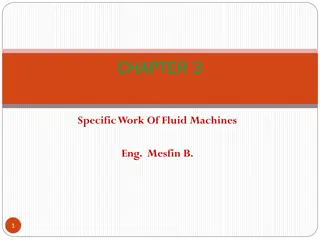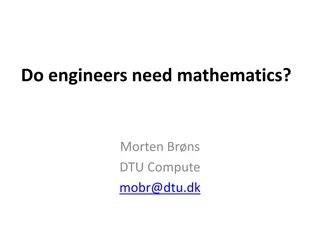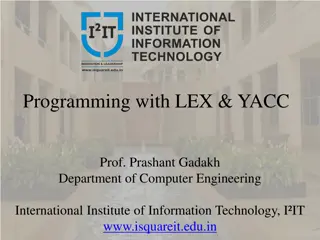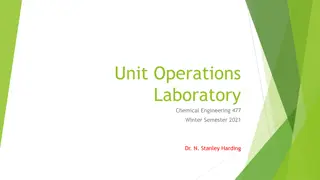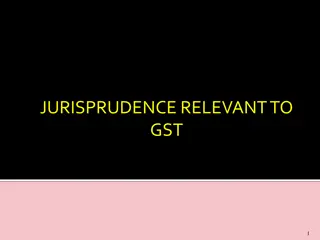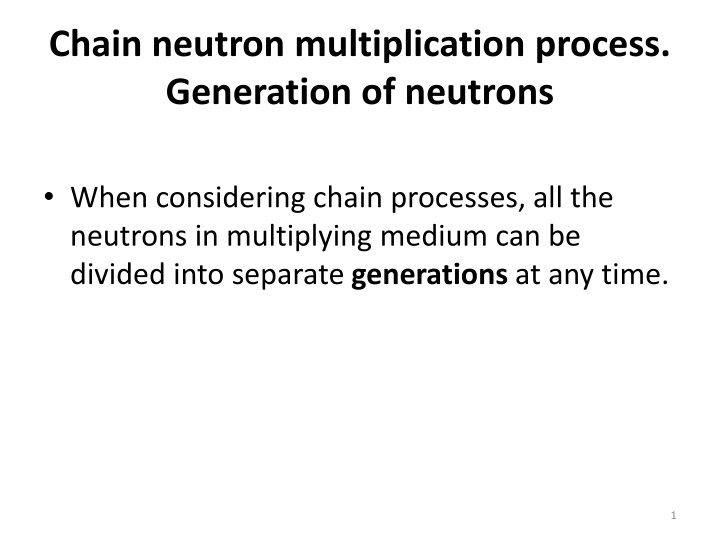
Neutron Multiplication in Chain Processes
Explore the chain neutron multiplication process in reactors, where neutrons go through generations, influencing reactor behavior. Simplifications in an infinite, homogeneous medium are discussed, along with the concept of neutron multiplication factor determining neutron density behavior.
Download Presentation

Please find below an Image/Link to download the presentation.
The content on the website is provided AS IS for your information and personal use only. It may not be sold, licensed, or shared on other websites without obtaining consent from the author. If you encounter any issues during the download, it is possible that the publisher has removed the file from their server.
You are allowed to download the files provided on this website for personal or commercial use, subject to the condition that they are used lawfully. All files are the property of their respective owners.
The content on the website is provided AS IS for your information and personal use only. It may not be sold, licensed, or shared on other websites without obtaining consent from the author.
E N D
Presentation Transcript
Chain neutron multiplication process. Generation of neutrons When considering chain processes, all the neutrons in multiplying medium can be divided into separate generations at any time. 1
Neutron of each generation involved in the chain fission process in the reactor core, passes the following life cycle: born in the fission reaction, moves in the core for some time, scattering on the nuclei of the medium (slows down and diffuses), then it either creates a new fission and neutrons of the next generation, or gets lost without the generation of new neutrons (for example, in the reaction of radiative capture) or leaves the multiplying medium. 2
Suppose that all the neutrons in the reactor have the same velocity and lifetime. Let's make some simplifications: 1. Multiplying medium is infinite, homogeneous and isotropic. 2. The same energy is ascribed to all neutrons in the medium (one-velocity model). 3. All neutrons of each generation are born at the same time, live a certain time (lifetime of one generation) and at the same time finish their life cycle, generating neutrons of the next generation. 4
In a homogeneous and infinite medium all unit volumes are equal. Therefore, to describe neutrons of each generation, we use function of neutron density which is defined as the number of neutrons per unit volume. Isotropism of medium and the use of one-velocity model allow to consider all the neutrons to be equal in terms of neutron and nuclear processes in the medium. 5
For such model of chain process, we introduce the concept of the neutron multiplication factor as the ratio of the number of neutrons of the next generation to the neutrons number of neutrons of the previous generation in each unit volume of the medium: ( i n K n + 1) = ( ) i 6
Multiplication factor determines the behavior of the neutron density in multiplying medium. For the chosen model, change in the time of the neutron density is described by a piecewise constant function of time. 7
However, if the time of generation is little and the multiplication factor is not very different from unity, temporal behavior of neutron density can be described by a continuous function of time. Suppose that at time t neutron density in the medium is equal to n(t), then after a time interval equal to the generation lifetime , as determined by the multiplication factor, their number will be increased by K times: n(t ) K n(t) + = 8
Consider the increment of the number of neutrons during the lifetime of one generation: n n(t = + ) n(t) (K = ) n(t) 1 If is little, the increment can be written by the derivative of the flux density: dn(t) dt + ) n(t) n(t 9
as a result we have the continuity equation for temporary changing of the neutron density in multiplying medium - evolution equation: ( ) dt 1 dn t K = ( ) n t 10
The solution of this equation is exponential function, whose exponent depends on the multiplication factor and on the generation life time: 11
If we denote ? = 1 the expression can be converted in the form: ? ? = ? 0 exp? ? In mathematics, for exponential function there is a notion of a period, equal to time, in which the value of the function increases by e times. 12
Consider the case when in the medium there is an external source of neutrons of constant power, not associated with fission reaction in the medium. Neutrons of this source are uniformly distributed in space and generate continuously in each unit volume (1 cm3) of q neutrons per second. In this case, the equation for the neutron density in the medium is: ( ) 1 dn t K dt = + ( ) n t q 13
General solution of inhomogeneous differential equation is the sum of two terms: 14
where n0- general solution of the homogeneous equation, and n1- particular solution of the inhomogeneous equation. 15
For critical multiplying medium K = 1 Then the number of neutrons per unit volume will vary linearly. Conclusion: in critical medium with external source stationary operation is impossible. But in subcritical medium the solution of this equation is: ? ? 1 ? ? ? = 17
The approach considered above for the consideration of neutron generations can be called a "model of succeeding generations". All neutrons were simultaneously produced simultaneously. Their lifetime was the same and equal to the average lifetime of the neutron in the reactor. They ended their existence simultaneously and gave birth to the next generation neutrons. 18
Naturally, in any multiplying medium, neutrons of different generations are simultaneously present and therefore the model of alternating generations does not have much practical significance. We consider the general case, assuming that q0neutrons were admitted into each unit volume of the multiplying medium at the initial instant of time. 19
We consider them to be neutrons of the first generation. After a while, they will all be absorbed and cause as a result of divisions a new neutron . 1.2 The Generation of Neutrons No. 1 1 0.8 Neutron density 0.6 0.4 0.2 0 0 2 4 6 8 10 12 14 16 18 20 Time, t/t0 20
The Generation of Neutrons No. 2 1 0.9 0.8 0.7 Neutron density 0.6 0.5 0.4 0.3 0.2 0.1 0 0 2 4 6 8 10 12 14 16 18 20 Time, t/t0 21
The Generation of Neutrons No. 3 1 0.9 0.8 0.7 Neutron density 0.6 0.5 0.4 0.3 0.2 0.1 0 0 2 4 6 8 10 12 14 16 18 20 Time, t/t0 22
The Generation of Neutrons No. 4 1 0.9 0.8 0.7 Neutron density 0.6 0.5 0.4 0.3 0.2 0.1 0 0 2 4 6 8 10 12 14 16 18 20 Time, t/t0 23
The Generation of Neutrons No. 7 1 0.9 0.8 0.7 Neutron density 0.6 0.5 0.4 0.3 0.2 0.1 0 0 2 4 6 8 10 12 14 16 18 20 Time, t/t0 24
1 The Generation of Neutrons No. 10 0.9 0.8 0.7 Neutron density 0.6 0.5 0.4 0.3 0.2 0.1 0 0 2 4 6 8 10 12 14 16 18 20 Time, t/t0 25
Consider the development of the chain process from generation to generation, In this case, the neutron generation is understood as all neutrons generated from neutrons of the previous generation. Within the single-speed model, single-group macroconstants in all generations will also be the same: , , V a f f 27
The neutron density of each generation will change with time. The time behavior of neutrons of zero generation will satisfy the equation: (0) ( ) t dN (0) = V N ( ) t a dt (0) (0) = = (0) , lim ( ) t 0 N Q N 0 t 28
Part of the neutrons of the zero generation will cause the fission of the nuclei of the medium, which will give rise to the next generation - N1(t). For neutrons of the first generation, the equation of time variation of their density in a medium has the form: (1) (1) ( ) a V N dt N N dN t (0) = + V N ( ) t ( ), t f f (1) (1) = = (0) 0, lim ( ) t 0 t 29
In the general case, for an arbitrary i-th neutron generation, we can write the analogous equation: ( ) i ( ) t dN ( 1) i ( ) i = V N + V N ( ) t ( ), t a f f dt ( ) i ( ) i = = = (0) 0, lim ( ) t 0, 0,1,... N N i t 30
Each generation unites all neutrons from the moment of their birth to the moment of disappearance (absorption), and each new generation serves as a source of the following. The total number of neutrons in each generation will be equal to the time integral of the source of these neutrons: ( ) i ( 1) i = V N ( ) t dt Q f f 0 31
We integrate each equation for the neutron density in time generation in the interval (0, ) and introduce the time integral density of neutrons in each generation: 32
Let us write the relations for successive generations of neutrons: (0) (0) (0) (0) (0) (0) = = = V N = , , , Q Q V N Q 0 a a = (1) (0) (1) (0) (1) (0) + = =0, , , Q a f f a f f f f ..., ( 1) i ( 1) i ( ) i ( ) i ( ) i = = = , , Q a f f f f a 33
, : Q . ( 1) i ( 1) i ( 2) i ( 1) i ( ) i = = = , Q f f f f a As a result, we obtain an expression for the multiplication factor of neutrons in an infinite multiplying medium . = ( 1) i f f f f = K ( 1) i a a The physical meaning of the result is that the multiplication factor is the ratio of the neutron production rate to the absorption rate. 34
Important consequences of the relations: The ratio of the integrated neutron fluxes for two successive generations is equal to the neutron multiplication factor :. ( ) ( ) i i Q K Q 2. : ( ) ( ) 0 a K . . 1. :. ( ) ( ) i i Q K Q 2. : ( ) ( ) 0 a K . . 1. = = ( 1) i ( 1) i = = ( 1) i ( 1) i The neutron balance for one generation is: i f f i = . i + f f = . i + 35
4. Neutron multiplication factor in subcritical medium the solution of this equation is: ? ? = ?? 1 ? If multiplying medium is subcritical (K <1), then a stationary process can be done in it. Total number of neutrons per unit volume depends on power of the external neutron source (q) and on how multiplication factor is close to unity. 36
Value has a special name multiplication factor of source power. Subcritical systems with an external source, which is considered as accelerators of protons, are based on this principle. 37
Features of the equation describing the behavior of neutrons and nuclear reactor itself allows to allocate some typical modes of operation: - Subcritical state (Keff<1) - in this case the first term can be neglected. 38
If considered medium is infinite, then it has no neutron leakage. In this case, parameter K is called neutron multiplication factor in infinite medium (Kinfor K ). 39
If dimensions of the medium are finite, moderating (fast) and thermal (which are in equilibrium with the nuclei of medium) neutrons has a probability of leakage from the reactor. 40
In this case, they are completely lost and do not participate in the multiplication process. In this case, K is called the effective neutron multiplication factor (Kef): Kef = Kinf* P Where the probability of avoiding leakage of neutrons from the reactor ( <1). 41
5. Notion of Reactivity, units of measurement The main characteristic that determines the balance of neutrons in the reactor core is effective multiplication factor kef, which takes into account neutron multiplication and capture processes in the core, and leakage of neutrons beyond it. 42
It follows from kef definition that per each neutron of the previous generation kef neutrons of the next generation are formed in the core, i.e. where: N change of number of neutrons in the reactor core during the lifetime of one generation of neutrons l. 43
Then for one neutron generation there is an increase (decrease) in the number of neutrons per one neutron of the previous generation: N / N = kef= kef 1, where value k is called excess multiplication factor. 44
Value kef, as well as N, can be greater than zero (when kef>1) and less than zero (when kef<1). In addition to factors Kefand kef, when analyzing the operation of a nuclear reactor, the notion of reactivity is introduced, which characterizes deviation degree of reactor from the critical state, = = 1 k k K K 45
Form the definition kef= N / N it follows that = N / N +1, i.e. reactivity is a change in the time of one generation of neutrons per one neutron of the new generation of neutrons. and kef= N +1/ N 46
If a rector is in the subcritical state, (<1), reactivity <0. If a reactor is in the critical state ( =1), reactivity =0. If a reactor is in the supercritical state, reactivity >0. When a reactor operates at constant capacity level kef 1, that's why kef. 47
Reactivity characteristic of a nuclear reactor, it reflects the entire complex of nuclear and physical processes taking place in the reactor core. To analyze non-stationary state of the reactor, it is more convenient to use the notion of reactivity. is the most important 48
It is explained mainly by the fact that in the critical state value =0 and kef=1 therefore in case of deviations from the critical state relative change in reactivity is much greater than the change of kef. 49
Absolute changes of and kef, are roughly the same, but relative - significantly different. On this basis, it is clear that >0 corresponds to the supercritical state of the reactor and <0 - to subcritical. 50





